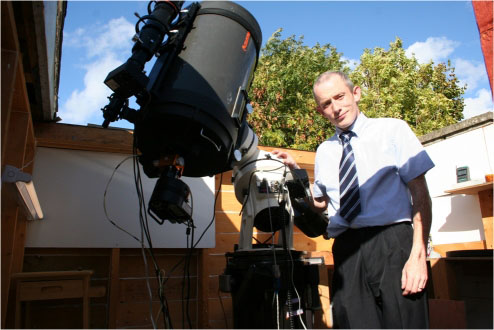Supernova 2012ej, which was discovered by the amateur irish astronomer Dave Grennan on 22 August 2012
From his back garden in Raheny, Co Dublin, an amateur astronomer called Dave Grennan has stumbled upon his second supernova discovery from Ireland in less than two years.
Grennan, who has an observatory in his back garden, made the astronomical discovery on the night of 22 August last. He said that the International Astronomical Union has since designated the supernova as 2012ej. It is around 120 million light years away from earth and is located in a galaxy called IC2166.
Back in September 2010 Grennan became the first person in Ireland to discover a supernova (2010 IK), an explosion that happened 290 million years ago.
Supernovae, or exploding stars, are the biggest explosion in the universe after the Big Bang, according to Astronomy Ireland.
According to Grennan who operates from his observatory which has a sliding roof, he was examining 117 galaxies on the night of 22 August when he made his latest discovery.
Having captured images of all 117 galaxies, Grennan set out to examine the first 116 to no success, with some of the images being marred by clouds. However, before shutting up for the night, Grennan decided to examine the final galaxy image only to discover it was a supernova after following up with more detailed images.

Dave Grennan pictured in his observatory in Raheny in north Dublin
Grennan, who works for CIE as an IT analyst, said that on any given clear night he would be stargazing, or rather his computer would be doing the groundwork.
“People imagine me peering through my telescope at strange hours in the morning but it’s actually not the case. It’s the computer that is doing the peering through the telescope and it takes photographs.”
He said that he was looking through the photographs that were taken on the evening of 22 August.
“On the very last photograph that was taken that evening it was clear to me that there was a new star that wasn’t there when I took a photograph of that same area of sky a few weeks ago.
“When I zoomed in a little bit closer I could see that this star is actually shining out of another distant galaxy and that’s when I knew that this was a supernova.”
Astronomical confirmation
Grennan said that he then had to clarify whether it was an already-known supernova.
“It turned out that nobody had spotted it before. Then it was a case of reporting it to the International Astronomical Union and they came back and said it was a new discovery.”
He said that he initially didn’t get excited until a couple of hours later after he realised the supernova was the real deal.
“I’ve got very good friends at Queen’s University Belfast who used a very powerful telescope in Las Palmas in the Canary Islands to look at that supernova for me and confirmed it.
“They could even tell me why this supernova happened. It was a star that got too heavy and basically collapsed in on itself and exploded.”
Explosion happened 120 million years ago
With the star having collapsed 120 million years ago, Grennan said that it has taken all this time for light from this supernova to travel across the universe.
“We’re looking back in time, in a way,” he said. “When we look at that supernova in the sky tonight we’re not seeing it as it is now but we’re actually seeing it as it was 120 million years ago.”
Seems quite mind boggling doesn’t it? And to get an idea of how far away this latest supernova is from us, one light year away from Earth is 6trn miles.
“Any time we look up at the night sky, any star we see, we’re looking at it in the past. For example the nearest star to us is four light years away. That means it has taken four years for the light from that star to travel to reach your eyes,” explained Grennan.
So, will scientists be interested in this supernova?
According to Grennan, supernovae help scientists to answer the most fundamental questions about the beginning of the universe, such as where it began and how is it going to end up. He said that there has already been plenty of interest from colleagues in astronomy since his discovery.
As for how his own interest in stargazing came about, Grennan recalls being six and looking up at the stars.
“I had very understanding parents who bought me a small telescope and they encouraged that interest.”
And even though supernova can’t officially be named, because they fade in due course, Grennan has already made his mark in the universe.
Back in 2008 he discovered a small asteroid orbiting between Mars and Jupiter. And that 3km-wide rock has since been named ‘Catherine Griffin’ after his late mother.